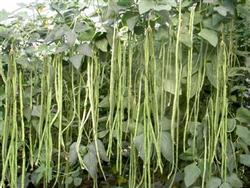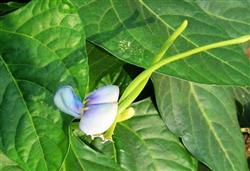Cultivation techniques of beans in early spring in plastic greenhouse

The cultivation techniques of beans in early spring in plastic greenhouse mainly include: variety selection, seedling cultivation, planting, field management, pest control, harvest and other important technical links. First, variety selection should choose early-maturing, high-quality, high-yield varieties, the main varieties are: purple flower oil bean, peanut oil bean, Haradou No. 1. Second, the seedlings are raised in a nutrient bowl in the greenhouse. The main results are as follows: 1. the sowing time is generally in the early and middle of March in the southern region and in the middle and late March in the northern region. Seeding rate per 667 square meters of transplanting field demand 4 Mel 5 kg, per square meter seedbed sowing amount of 100 grams. When sowing, the soil water content of the seedling bed should reach more than 80%, and the soil temperature of the bed soil in the greenhouse should be kept above 12 ℃. The temperature is 20 ℃ 25 ℃ during the day and 15 ℃ at night. When sowing, the nutrition bowl should be poured through the bottom water. After the water seeps, each nutrition bowl will sow 3Mel 4 germinated seeds, cover the soil with 1.5cm, and then buckle the small arch shed. 2. The preparation work before sowing mainly includes the following three aspects. (1) the making of seeding bed and the preparation of nutritious soil the seeding bed in the greenhouse should be determined according to the size of the greenhouse, and the nutrition bowl should be placed in the seedling bed. Preparation of nutritious soil: use 60% garden soil, 30% mature organic fertilizer, 10% mature manure fertilizer, and then add rhizobium fertilizer and long-acting microbial compound fertilizer to mix evenly. Then the prepared nutrient soil is loaded into a nutrition bowl with a diameter of 8cm or 10cm and high 12cm. (2) when sowing seeds, select large, full and disease-free dry seeds, soak in 1% formalin solution for 20 minutes to kill anthracnose on the seed surface, rinse with clean water and cool dry. (3) three days before germination and sowing, the seeds were soaked in normal temperature water for 4 hours, germinated at 30 ℃ for 24 hours, and the radicle broke the seed coat. 3. Temperature and water management at seedling stage, from sowing to emergence, 20-25 ℃ in daytime, 15 ℃ at night, cotyledon flattened after 4 days, film removed to cool down. The naive leaves appeared at 15 ℃ in the daytime, and the true leaves expanded to 10 days before planting. The temperature should be increased at 20 ℃ in the daytime to facilitate flower bud differentiation and root leaf growth. Seedling exercise was carried out 10 days before planting, 15 ℃ in the daytime and 12-15 ℃ at night. In terms of water management, because kidney bean seedlings are more drought-tolerant, according to the growth of seedlings and soil moisture, appropriate water supply 2Mel 3 times, neither too dry nor too wet. The standard of strong seedling, the strong seedling with good exercise, the plant clump is short and strong, the root system is well developed, 2 Mel 3 true leaves, the seedling age is 30 mi 35 days. 3. Planting 1. Preparation before planting (1) to apply basic fertilizer for land preparation, choose flat and sunny plots of land, apply 60 tons of organic fertilizer per hectare as base fertilizer, and then plough the land to make beds. (2) buckle the shed for 25 days before planting, generally in the middle of February-March, the greenhouse film is made of non-drop anti-aging greenhouse film, and the polyethylene plastic film is 120 kg per 667 square meters. 2. Colonization (1) temperature index and heat preservation measures in the safe period of planting when kidney beans are planted in the greenhouse, the soil temperature in the greenhouse must be more than 10 ℃, and the temperature at night is not less than 8 ℃, usually in the first and middle of April. The thermal insulation measures during planting: the internal thermal insulation adopts the small greenhouse in the greenhouse, the double-layer curtain is hung, and the warm air stove in the shed is used if necessary, and the external thermal insulation is mainly covered with grass mulch around the shed. (2) planting method and density of dwarf kidney bean, hole spacing 30cm*60cm, seedling protection per mu 8000Mel 10000 plants, trailing bean generally border planting, border width 1.2cm, double row per border planting, plant spacing 20-25cm, seedling preservation per mu 8000 plants, trailing species can also be interplanted with green leafy vegetables such as rape, high border cultivation, border width 1m, double rows per border, distance 25cm, plant spacing of three rows of rape between rows is 10cm; rape is pulled out before flowering and vine is introduced at the same time. When planting, ditch irrigation, it is appropriate to wet through the soil, and then covered with dry soil. 4. Field management 1. Management after planting to before flowering and podding (1) after planting slow seedlings, kidney beans should be ploughed to loosen the soil, which is beneficial to the increase of soil temperature and promote root growth, generally from after planting to before flowering, every other week or so, that is, intertillage. The middle ploughing should be deep, and with the middle ploughing, the soil should be properly cultivated to the rhizome. Lateral roots continue to occur in the rhizome. (2) temperature and water management after colonization: 20-25 ℃ in daytime, 15 ℃ at night, about 20 ℃ in daytime and more than 15 ℃ at night to facilitate normal flowering and pod bearing. In terms of water management, because kidney beans have a certain ability of drought tolerance, there is generally no irrigation and fertilization from planting to flowering to prevent excessive growth of stems and leaves. At the beginning of flowering, it is necessary to increase the amount of air release and remove moist air so as to facilitate pollination, avoid falling flowers and reduce diseases. (3) the trailing species should set up a frame when the vine stem is pulled out of 30cm, the double-row planting can combine the two rows into a Chevron frame, and the single-row planting should set up a frame or Chevron frame. 2. Management of podding period (1) Fertilizer and Water Management when dwarf beans present flower buds, trailing beans begin to top fertilize and irrigate, so as to promote the rapid growth of seedling pods. Combined with irrigation, diammonium phosphate was applied once, according to 225-300kg per hectare, once every 10 days, the amount of water each time should not be too large, trailing species could be irrigated once in 15 days, topdressing 3 times chemical fertilizer, 150-225kg diammonium phosphate every time. Soak the seeds with 0.03% ammonium molybdate or spray the plants. It can promote the early ripening of kidney beans and increase the early yield. (2) ventilation management ventilation, generally do not carry out ventilation within a week after planting, so that the greenhouse to maintain high temperature, in order to slow down the seedlings. When the temperature exceeds 30 ℃, it should be ventilated in a short time at noon and keep about 25 ℃ from slow seedling to flowering stage to promote growth. When the flowering and pod setting period is kept at about 20 ℃, the wind volume is large, which is beneficial to pollination, fruiting and pod hypertrophy. High temperature and humidity will cause falling flowers, the humidity should be kept at 75%, and the bottom wind should be released day and night after the final frost period. 5. Pest control. 1. Disease control during flowering and podding period, 3000 times trimethoprim can be used to control rust; 600 times liquid 75% chlorothalonil can be used to control gray mold, red spot and anthrax. 5% chlorothalonil dust agent can be used to control gray mold and anthrax. 2. Pest control during the growing period, 1,500 times of dimethoate was used to control aphids, and 2000 times of 3000 times of 40% chrysanthemum EC or 3000 times of 3000 times was used to control cabbage green insects, cabbage night moths, aphids and red spiders. Sixth, the beans on the market are tender pods for consumption, and when the pods reach commercial maturity, they should be harvested at the right time. In general, the dwarf species began to be harvested 25-35 days after planting, and the vine species began to be harvested at 35: 45 days after planting, once every 5 days, and once every 2 days at the peak podding period. Late harvest affects the quality and the pod setting of subsequent inflorescences. The pods harvested should be put on the market in time, and those not on the market can be kept fresh in the environment of 3 ℃. Seventh, clean the countryside and remove the diseased plants and leaves in time. Burn it and bury it in one place. Pods were harvested in early July. The shelves should be centrally stored to prevent the harm of bacteria and insect eggs on the diseased plants in the second year, so as to achieve the role of prevention and control of diseases and insect pests.
- Prev

Soy beans to prevent falling flowers
The phenomenon of falling flowers will occur in kidney beans when the temperature is above 30 degrees Celsius or the soil is too dry and wet in windy weather, lack of nutrients and weak light, so field management should be strengthened to prevent flowers and fruits from falling. Experiments have proved that the application of biological potassium fertilizer can reduce the occurrence of flower and fruit drop.
- Next

Common diseases and insect pests of beans and their control
Common diseases and insect pests of beans and their control
Related
- Where is it suitable to grow horseradish in China? it is expected to see the middle altitude horseradish in Alishan.
- How to prevent tomato virus disease reasonably? (Control methods included)
- Many people like to plant towel gourd on the balcony. What are the main points of this method and management?
- What crops can chili peppers be mixed with?
- Fertilization techniques and matters needing attention in Tomato
- What are the grafting techniques for peach seedlings in spring?
- Harm and control methods of root swelling disease of Chinese cabbage
- What are the pests of sweet potatoes? How to prevent and cure it?
- Symptoms, causes and Control methods of navel Rot in Tomato
- The cause of "Cucumber rotten bibcock" in Farmers' planting Cucumber and its Control Plan

